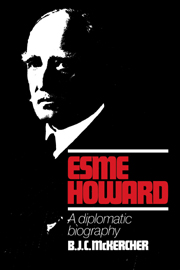Book contents
- Frontmatter
- Contents
- Acknowledgements
- List of abbreviations
- 1 The making of a diplomat, 1863–1903
- 2 Crete: consulship and civil war, 1903–1906
- 3 Washington: Imperial affairs and arbitration, 1906–1908
- 4 Budapest and Berne: prelude to the Great War, 1908–1913
- 5 Stockholm: war and diplomacy in neutral northern Europe, 1913–1916
- 6 Stockholm: diplomacy and war in neutral northern Europe, 1916–1918
- 7 Paris: Poland, the Baltic States, and the Treaty of Versailles, 1918–1919
- 8 Madrid: Anglo-Spanish relations, 1919–1924
- 9 Washington redux: rebuilding good relations, 1924–1927
- 10 Washington redux: meeting the American challenge, 1927-1930
- Epilogue and conclusion ‘A great ambassador’
- Notes
- Bibliography
- Index
Epilogue and conclusion ‘A great ambassador’
Published online by Cambridge University Press: 06 October 2009
- Frontmatter
- Contents
- Acknowledgements
- List of abbreviations
- 1 The making of a diplomat, 1863–1903
- 2 Crete: consulship and civil war, 1903–1906
- 3 Washington: Imperial affairs and arbitration, 1906–1908
- 4 Budapest and Berne: prelude to the Great War, 1908–1913
- 5 Stockholm: war and diplomacy in neutral northern Europe, 1913–1916
- 6 Stockholm: diplomacy and war in neutral northern Europe, 1916–1918
- 7 Paris: Poland, the Baltic States, and the Treaty of Versailles, 1918–1919
- 8 Madrid: Anglo-Spanish relations, 1919–1924
- 9 Washington redux: rebuilding good relations, 1924–1927
- 10 Washington redux: meeting the American challenge, 1927-1930
- Epilogue and conclusion ‘A great ambassador’
- Notes
- Bibliography
- Index
Summary
At the beginning of 1924 Sir Auckland Geddes resigned the post of Ambassador at Washington, and Sir Esme Howard was appointed in his place. His mission was a great personal triumph. He remained six years in the United States, and takes rank with Stratford, Canning, Lord Lyons, and Bryce, among the greatest of his predecessors.
The Times, August 1939Howard's work in the United States represented a monument, albeit one of spirit rather than substance, to good Anglo-American relations. More tangibly, he also left as a monument a new British Embassy. Whilst containing spacious reception rooms which made entertainment easy, the old Embassy's offices and chancery were built for another age. They were cramped for the number of diplomats needed to conduct British official business in the United States, and they were outmoded for modern typewriters, coding machines, and other technology fundamental to post-Great War diplomacy. More important, Howard believed that the old Embassy, a forbidding Victorian structure with a dark interior, had for too long been a place of sorrow for the diplomats serving at Washington: Lord Pauncefote, Durand's predecessor, had died there in 1902; Durand had been the object of Roosevelt's private indignities; Spring Rice had been disgraced by his recall in 1917 and died before reaching Britain; and, most telling, Howard's first three years as ambassador had been marked by his eldest son's illness and death.
- Type
- Chapter
- Information
- Esme HowardA Diplomatic Biography, pp. 352 - 375Publisher: Cambridge University PressPrint publication year: 1989



